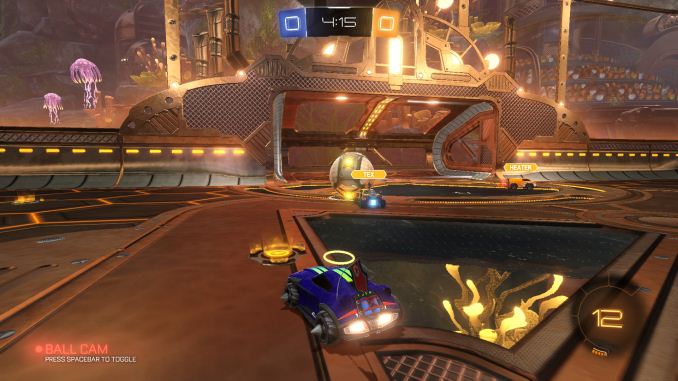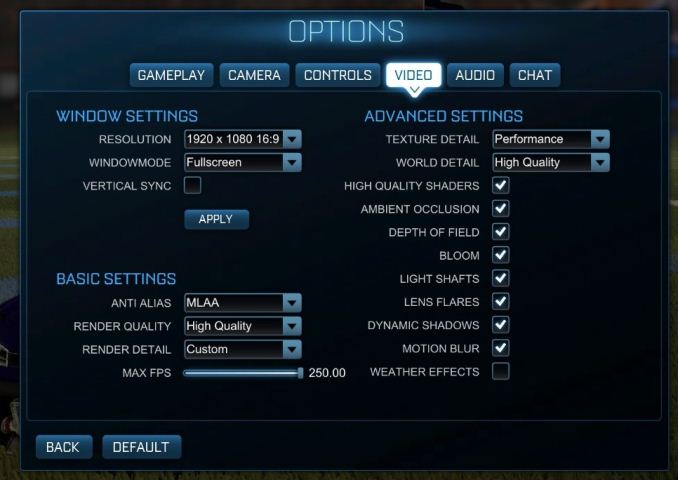Retesting AMD Ryzen Threadripper’s Game Mode: Halving Cores for More Performance
by Ian Cutress on August 17, 2017 12:01 PM ESTRocket League
Hilariously simple pick-up-and-play games are great fun. I'm a massive fan of the Katamari franchise for that reason — passing start on a controller and rolling around, picking up things to get bigger, is extremely simple. Until we get a PC version of Katamari that I can benchmark, we'll focus on Rocket League.
Rocket League combines the elements of pick-up-and-play, allowing users to jump into a game with other people (or bots) to play football with cars with zero rules. The title is built on Unreal Engine 3, which is somewhat old at this point, but it allows users to run the game on super-low-end systems while still taxing the big ones. Since the release in 2015, it has sold over 5 million copies and seems to be a fixture at LANs and game shows. Users who train get very serious, playing in teams and leagues with very few settings to configure, and everyone is on the same level. Rocket League is quickly becoming one of the favored titles for e-sports tournaments, especially when e-sports contests can be viewed directly from the game interface.
Based on these factors, plus the fact that it is an extremely fun title to load and play, we set out to find the best way to benchmark it. Unfortunately for the most part automatic benchmark modes for games are few and far between. Partly because of this, but also on the basis that it is built on the Unreal 3 engine, Rocket League does not have a benchmark mode. In this case, we have to develop a consistent run and record the frame rate.
Read our initial analysis on our Rocket League benchmark on low-end graphics here.
With Rocket League, there is no benchmark mode, so we have to perform a series of automated actions, similar to a racing game having a fixed number of laps. We take the following approach: Using Fraps to record the time taken to show each frame (and the overall frame rates), we use an automation tool to set up a consistent 4v4 bot match on easy, with the system applying a series of inputs throughout the run, such as switching camera angles and driving around.
It turns out that this method is nicely indicative of a real bot match, driving up walls, boosting and even putting in the odd assist, save and/or goal, as weird as that sounds for an automated set of commands. To maintain consistency, the commands we apply are not random but time-fixed, and we also keep the map the same (Aquadome, known to be a tough map for GPUs due to water/transparency) and the car customization constant. We start recording just after a match starts, and record for 4 minutes of game time (think 5 laps of a DIRT: Rally benchmark), with average frame rates, 99th percentile and frame times all provided.
The graphics settings for Rocket League come in four broad, generic settings: Low, Medium, High and High FXAA. There are advanced settings in place for shadows and details; however, for these tests, we keep to the generic settings. For both 1920x1080 and 4K resolutions, we test at the High preset with an unlimited frame cap.
All of our benchmark results can also be found in our benchmark engine, Bench.
MSI GTX 1080 Gaming 8G Performance

1080p



4K



Sapphire Nitro R9 Fury 4G Performance

1080p



4K



Sapphire Nitro RX 480 8G Performance

1080p



4K



With Ryzen, we encounted some odd performance issues when using NVIDIA-based video cards that caused those cards to significantly underperform. However equally strangely, the issues we have with Ryzen on Rocket League with NVIDIA GPUs seem to almost vanish when using Threadripper. Again, still no easy wins here as Intel seems to take Rocket League in its stride, but Game mode still helps the 1950X. The Time Under graphs give some cause for concern, with the 1950X consistently being at the bottom of that graph.












104 Comments
View All Comments
silverblue - Friday, August 18, 2017 - link
I'd like to see what happens when you manually set a 2+2+2+2 core configuration, instead of enabling Game Mode. From what I've read, Game Mode destroys memory bandwidth but yields better latency, however it's not answering whether Zen cores can really benefit from the extra bandwidth that a quad-channel memory interface affords.Alternatively, just clock the 1950 and 1920 identically, and see if the 1920's per-core performance is any higher.
KAlmquist - Friday, August 18, 2017 - link
“One of the interesting data points in our test is the Compile. Because <B>this test requires a lot of cross-core communication</B> and DRAM, we get an interesting metric where the 1950X still comes out on top due to the core counts, but because the 1920X has fewer cores per CCX, it actually falls behind the 1950X in Game Mode and the 1800X despite having more cores.”Generally speaking, copmpilers are single threaded, so the parallelism in a software build comes from compiling multiple source files in parallel, meaning the cross-core communication is minimal. I have no idea what MSVC is doing here, can you explain? In any case, while I appreciate you including a software development benchmark, the one you've chosen would seem to provide no useful information to anyone who doesn't use MSVC.
peevee - Friday, August 18, 2017 - link
I use MSVC and it scales pretty well if you are using it right. They are doing something wrong.KAlmquist - Saturday, August 19, 2017 - link
Thanks. It makes sense that MSVC would scale about as well as any other build environment.ARS Technica also benchmarked a Chromium build, which I think uses MSVC, but uses the Google tools GN and Ninja to manage the build. They get:
Ryzen 1800X (8 cores) - 9.8 build/day
Threadripper 1920X (12 cores) - 16.7 build/day
Threadripper 1950X (16 cores) - 18.6 build/day
Very good speedup with the 1920X over the 1800X, but not so much going from the 1920X to the 1950X. Perhaps the benchmark is dependent on memory bandwidth and L3 cache.
Timur Born - Friday, August 18, 2017 - link
Thanks for the tests!I would have liked to see a combination of both being tested: Game Mode to switch off the second die and SMT disabled. That way 4 full physical cores with low latency memory access would have run the games.
Hopefully modern titles don't benefit from this, but some more "legacy" ones might like this setup even more.
Timur Born - Friday, August 18, 2017 - link
Sorry, I meant 8 cores, aka 8/8 cores mode.mat9v - Friday, August 18, 2017 - link
I wish someone had an inclination to test creative mode but with games pinned to one module. It is essentially NUMA mode but with all cores active.Or just enable SMT that is disabled in Gaming Mode - we actually then get a Ryzen 1800X CPU that overclocks well but with possibly higher performance due to all system task running on different module (if we configure system that way) and unencumbered access to more PCIEx lines.
peevee - Friday, August 18, 2017 - link
Yes, that would be interesting.c:\>start /REALTIME /NODE 0 /AFFINITY 5555 you_game_here.exe
mat9v - Friday, August 18, 2017 - link
I think I would start it on node 1 is anything since system task would be at default running on node 0.Mask 5555? Wouldn't it be AAAA - for 8 cores (8 threads) and FFFF for 8 cores (16 threads)?
peevee - Friday, August 18, 2017 - link
The mask 5555 assumes that SMT is enabled. Otherwise it should be FF.When SMT is enabled, 5555 and AAAA will allocate threads to the same cores, just different logical CPUs.
Where system threads will be run is system dependent, nothing prevents Windows from running them on NODE 1. /NODE 0 allows to run whether or not you actually have multiple NUMA nodes.
With /REALTIME Windows will have hard time allocating anything on those logical CPUs, but can use the same cores with other logical CPUs, so yes, technically it will affect results. But unless you load it with something, the difference should not be significant - things like cache and memory bus contention are more important anyway and don't care on which cores you run.